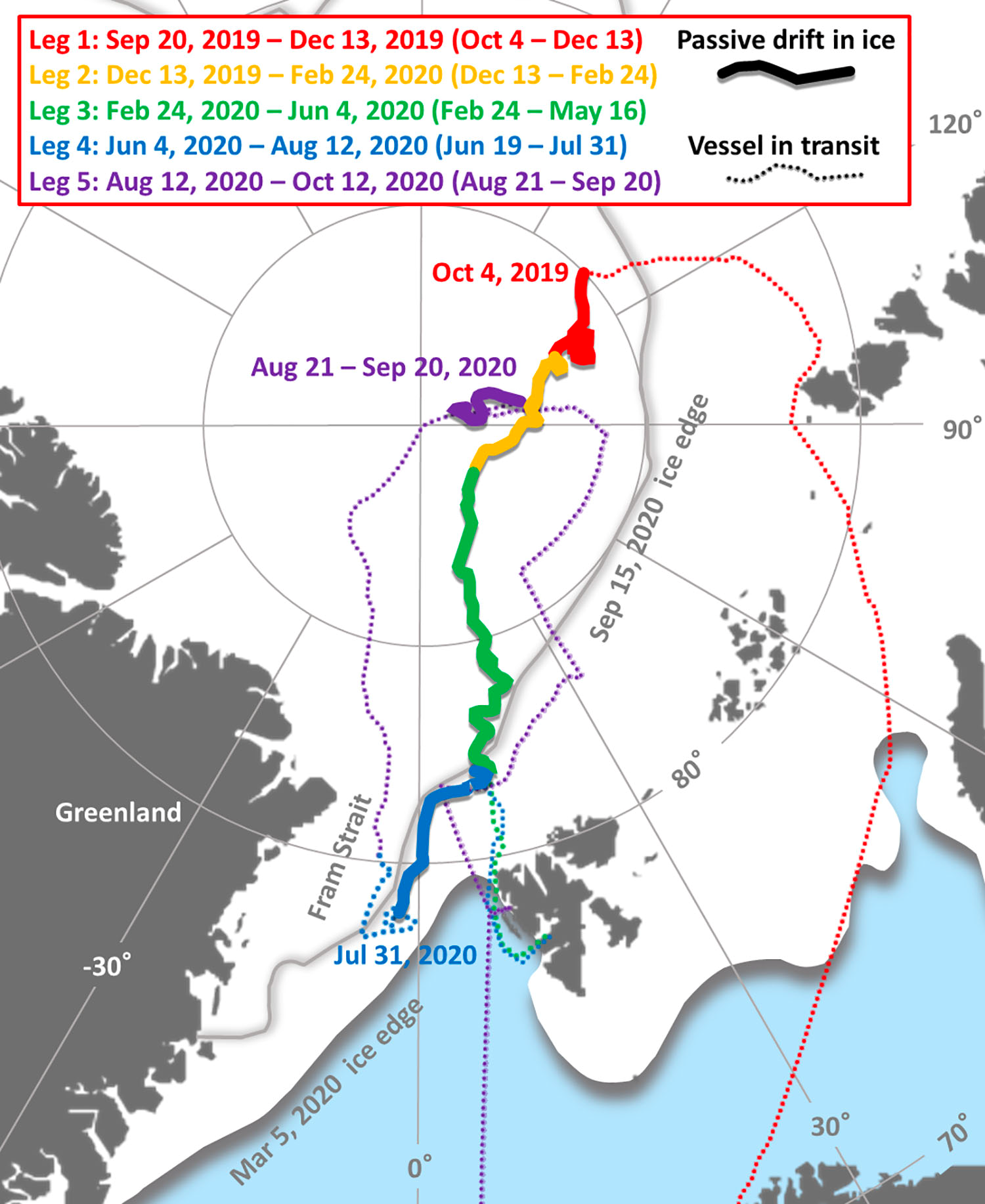Arctic sea ice decline is expected to impact the Arctic physical environment and ecosystem. We combine in situ measurements from MOSAiC fieldwork with state–of–the–art computer modelling to quantify current and future changes in the Arctic.
Hundreds of international researchers, including scientists from the National Oceanography Centre (NOC) are currently analysing observations from the one-year MOSAiC expedition.
During the expedition, hundreds of environmental parameters were recorded with unprecedented accuracy and frequency over a full annual cycle in the Central Arctic Ocean. The NOC contributed to the collaborative programme, with joint analysis of the observational data and results from the high-resolution coupled models on ocean, sea ice and biogeochemistry.
MOSAiC researchers have now published three overview articles on the MOSAiC atmosphere, snow and sea ice, and ocean programs in the journal Elementa, highlighting the importance of examining all components of the climate system together. These results present the first complete picture of the climate processes in the central Arctic which is warming more than two times as fast as the rest of the planet – processes which affect weather and climate worldwide.
Participation of the researchers from the NOC in the MOSAiC Programme was funded through the project “Advective Pathways of nutrients and key Ecological substances in the ARctic (APEAR)”. The project was coordinated by Drs Yevgeny Aksenov (NOC) and Benjamin Rabe (AWI) and included a strong international team of physical oceanographers and researchers in sea ice and marine biogeochemistry from the UK, Germany, Sweden, Norway and Canada. The project was a part of the £16m UK Changing Arctic Ocean Programme funded by the UK Natural Environment Research Council/UK Research and Innovation (NERC/UKRI) and co-funded by the German Federal Ministry of Education and Research (BMBF).
The NOC’s Dr Yevgeny Aksenov, Principal Investigator of APEAR and a member of the MOSAiC Team Ocean said: “Arctic sea ice decline is expected to impact the Arctic physical environment and ecosystem. We combine in situ measurements from MOSAiC fieldwork with state–of–the–art computer modelling to quantify current and future changes in the Arctic.”
The NOC’s Dr Chris Wilson, APEAR Co-Investigator added: “This study is of particular significance to our predictions into new aspects of The Arctic, as well as the global climate. It also provides us with crucial insight into how we can continue to develop and improve our future predictions of the Arctic environment.”
Diminishing sea ice is a symbol of ongoing global warming: in the Arctic, its extent has almost halved in summer since satellite records began in the 1980s. Less well studied but equally relevant are the thickness and other properties of the ice. The question of what this means for the future Arctic and how these changes will affect the global climate were the impetus for the historic MOSAiC expedition with the German research icebreaker Polarstern from September 2019 to October 2020. With these results coming out now the researchers are building the most complete observation-based picture of climate processes in the Arctic, where the surface air temperature has been rising more than two times as fast as on the rest of the planet since the 1970s. To study the relevant processes for a full year required a special concept, in part because the Central Arctic Ocean is still ice-covered in winter and therefore difficult to access. During the expedition, the icebreaker froze to a large ice floe and drifted with the natural transpolar drift across the Arctic Ocean. And this is where the first surprises came. "We found more dynamic and faster drifting pack ice than expected. This not only challenged the teams on the ground in their daily work, but above all resulted in changed sea-ice properties and sea-ice thickness distributions," reports Dr Marcel Nicolaus, sea-ice physicist at the Alfred Wegener Institute, Helmholtz Centre for Polar and Marine Research (AWI) and co-leader of Team Ice in the MOSAiC project.

The oceanography team of the programme is analysing how atmosphere and sea ice changes are related to the water temperature and salinity. "We observe an increasing connection between the upper ocean and the deeper warm water layers in the Central Arctic Ocean, year-round," reports Dr Céline Heuzé, physical oceanographer at the University of Gothenburg (Sweden) and co-leader of the MOSAiC Team Ocean. "We were able to fully map ocean eddies over a complete annual cycle during the expedition. Nearly simultaneous measurements from Polarstern, our camp set up next to it on the ice and the distributed network up to 50 kilometres away from the ship provide the first assessment of small-scale events up to the regional scale," adds Dr Benjamin Rabe, co-leader of the MOSAiC Team Ocean and physical oceanographer at the AWI.
"The physical observations are the basis for interpreting biogeochemical cycles and ecosystem processes, and for supporting coupled models that we use to learn even more about climate feedbacks and the global repercussions of Arctic change. These changes can affect weather and climate worldwide. It is fascinating how accurately we can map individual processes and relate them to each other. I am pleased to see how several hundred MOSAiC participants have collaborated on these publications. International cooperation with expedition participants from so many countries continues productively in a highly coordinated manner, even though the expedition has been over for more than a year. In this way, we will be able to provide ever more important insights into climate change, which will provide a knowledge base for societal transformation towards a sustainable approach to planet Earth" says Prof. Markus Rex, head of MOSAiC and atmospheric scientist at the AWI.

